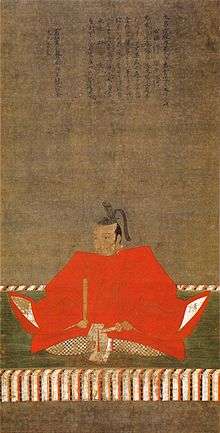Okudaira Nobumasa

Okudaira Nobumasa (奥平 信昌, 1555 – April 11, 1615) was a Japanese daimyō of the Sengoku and early Edo periods.[1] Nobumasa's family considered their origins to have been associated with Mikawa Province. The clan was descended through the Akamatsu from the Murakami-Genji.[2]
Early life
When Nobumasa was born, he was called Sadamasa (奥平 貞昌).[2] He was the son of Okudaira Sadayoshi, an influential local figure in Mikawa. The Okudaira family were originally retainers of the Tokugawa, but were forced to join Takeda Shingen. After Shingen died and Katsuyori assumed leadership of the Takeda clan, Okudaira Sadamasa walked his men out of Tsukude Castle and rejoined the Tokugawa.
Katsuyori had Sadamasa's wife and brother – hostages to the Takeda – crucified for what the Takeda construed as betrayal.[3]
Nagashino
Sadamasa was entrusted with the defense of Nagashino Castle by Tokugawa Ieyasu.[4]
Sadamasa's decision to remove himself and his forces from the Takeda supporters became one of the antecedents of the Battle of Nagashino in 1575. Katsuyori was enraged at Sadamasa's decision to leave the Takeda forces. Nagashino Castle was attacked by Katsuyori with a force of 15,000 troops; but Sadamasa held firm, repelling the Takeda siege until forces of a Tokugawa-Oda alliance eventually arrived to support the beleaguered Okudaira. Oda Nobunaga was so impressed by the Okudaira's performance in the battle that he offered Sadamasa the honor of adopting part of his name—Nobu. After the battle was won, the hardy warrior was changed from Sadamasa to Nobumasa.[2]
Later life
Tokugawa allowed Nobumasa to marry his eldest daughter, Kamehime ; and he was given Nagashino Castle. In 1590, Nobumasa was given a fief in Miyazaki, Kōzuke.[2]
Nobumasa served as the first Kyoto shoshidai of the Edo period.[5] When Nobumasa completed his service as Kyoto shoshidai in 1601, he was transferred to Kanō Domain in Mino Province.[2] He built Kanō Castle in Gifu, Gifu Prefecture, and commissioned the building of Kanō Tenman-gū.
Notes
- ↑ Meyer, Eva-Maria. "Gouverneure von Kyôto in der Edo-Zeit." Archived 2008-04-11 at the Wayback Machine. Universität Tübingen (in German).
- 1 2 3 4 5 Papinot, Edmund. (2003). Nobiliare du Japon -- Okudaira, p. 47; Papinot, Jacques Edmond Joseph. (1906). Dictionnaire d’histoire et de géographie du Japon. (in French/German).
- ↑ Turnbull, Stephen (1987). Battles of the Samurai. London: Arms and Armour Press. pp. 79–94. ISBN 9780853688266.
- ↑ Turnbull, Stephen (1977). The Samurai. New York: Macmillan Publishing Co., Inc. pp. 156–160. ISBN 9780026205405.
- ↑ Murdoch, James. (1996). A History of Japan, pp. 10, 160.
References
- Meyer, Eva-Maria. (1999). Japans Kaiserhof in de Edo-Zeit: Unter besonderer Berücksichtigung der Jahre 1846 bis 1867. Münster: Tagenbuch. ISBN 3-8258-3939-7
- Murdoch, James. (1996). A History of Japan. London: Routledge. ISBN 0-415-15417-0
- Papinot, Edmond. (1906) Dictionnaire d'histoire et de géographie du japon. Tokyo: Librarie Sansaisha...Click link for digitized 1906 Nobiliaire du japon (2003)
- Sasaki Suguru. (2002). Boshin sensō: haisha no Meiji ishin. Tokyo: Chūōkōron-shinsha.
| Preceded by none |
1st (Okudaira) Daimyō of Obata 1590–1601 |
Succeeded by Mizuno Tadakiyo |
| Preceded by none |
1st (Okudaira) Daimyō of Kanō 1601–1602 |
Succeeded by Okudaira Tadamasa |
| Preceded by none |
1st Kyoto Shoshidai 1600–1601 |
Succeeded by Itakura Katsushige |